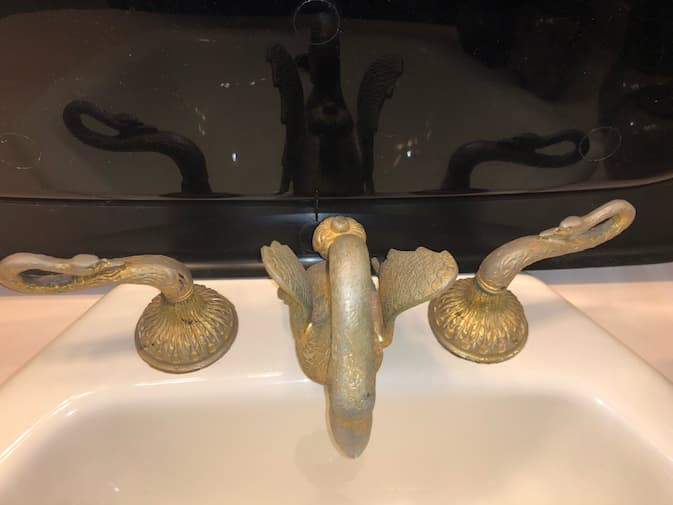
-----
Gold flash vs. plate
April 21, 2021
Q. I have a faucet set with a matching towel bar, towel ring and toilet paper dispenser that was previously plated in 24k but has tarnished from cleaning and/or usage. The faucet/basin set appears to have worn the worst of all the other pieces. I believe they're brass.

I'm interested in re-plating the set in 24k, bright gold, satin finish.
Can you provide the job specs to complete this project properly? How many microns of gold are suggested? Should the pieces be finished in a lacquer coating to protect against use? Anything else that's suggested?
Any and all information will be greatly appreciated.
- New York, NY
A. Hi Lori. That's beautiful old stuff you've got there. I'd guess you probably need underlayers of copper (mush buffed to restore smoothness), nickel for brightness and as a diffusion barrier, gold (probably about 1/4 to a 1/2 micron, but a full micron wouldn't hurt except for doubling the price of the gold), and a clear coat for durability (gold is inert, so strictly speaking clear coating is not necessary, but using gold as a wear surface when it will be scrubbed is probably impractical).
Still, trying to write your/our own specs for a one-off job may not work to get you a quality job. I'd suggest trying your best to find a shop with experience in very similar stuff. I'm not sure who can quote on this, but in the NYC area I'd suggest talking to Epner Technology in Brooklyn and SA Baxter on Lexington Ave. Even if they can't quote they almost surely have experience in referring people to someone who can.
Luck & Regards,

Ted Mooney, P.E. RET
Striving to live Aloha
finishing.com - Pine Beach, New Jersey
Ted is available for instant help
or longer-term assistance.
April 2021
⇩ Related postings, oldest first ⇩
Q. I'm wondering whether there are any standards regarding what thickness of gold constitutes "flash" and what constitutes "plating". In particular for the terminals/pins on connectors.
Thank you.
cables - Santa Ana, California, USA
2005
A. Those terms are meaningless.

Jeffrey Holmes, CEF
Spartanburg, South Carolina
2005
A. In electronics plating these terms are not recognized.
In the jewelry industry there are distinctions for "flash", gold plate and heavy gold electroplate.
"Flash" refers to thicknesses less than 7 millionths; gold plate, above 7 millionths; and heavy gold electroplate, 100 millionths of an inch. All measurements are expressed in terms of 24 karat gold.
E. Providence, Rhode Island
2005
A. G'day, The term flash means to just cover the job with enough gold to give it a uniform color. Usually a cyanide gold. The term plating is short for electroplating. Connectors have varied uses. Some require more gold than others. Most mobile phone connectors have a thickness of 1.25 microns near the tip. Most connectors are electroplated in an acid hard gold first. This gold is an alloy and offers better mechanical wear protection. Then a flash of 24 kt cyanide gold to give it an even color.
Richard Bancroft- Carrum, Vic, Australia
2005
A. Flash gold plating is less than 0.25 Microns and usually not done on connectors. For this purpose, Cobalt or Nickel hardened additives are used in the Acid gold bath and usually a thickness of >1.0 Micron gold is deposited and is subjected to tests such as contact resistance, wear resistance, porosity etc.
In this case Mr. Bruce J has to set his requirement first.

T.K. Mohan
plating process supplier - Mumbai, India
2005
A. Bruce:MIL-DTL-45204, Paragraph 6.3.1 defines a strike/flash as any plated material under 10 micro-inches or .000010. Depending on your application, we see 30 micro-inches of gold commonly on commercial connector applications. Mil-specs such as 39029 are 50 micro-inches min but also allow localized finishing. We routinely process size 16-22 gauge pc tail contacts and sockets with copper flash, nickel 50 min, gold flash/strike overall then selective plating mating end of socket or contact.
Casey Weizel, PresidentForesight Finishing LLC
- Tempe, Arizona

December 20, 2012
A. Hi Bruce. A parallel if I may: in English grammar class we learn the distinction between words like "which" and "that" -- when & why we ought to use the one rather than the other. If your desire were merely to try to use the word "flash" vs. "plate" in 'grammatically correct' fashion in a particular industry segment, you've just heard 5 good explanations.
But I think the central point is that trying to specify the thickness of gold plating by calling it a flash, or trying to determine what someone if offering you by the fact that they called it a flash, will prove hopeless. Thickness must be specified, not inferred from the word "flash". Good luck.
Luck & Regards,

Ted Mooney, P.E. RET
Striving to live Aloha
finishing.com - Pine Beach, New Jersey
Ted is available for instant help
or longer-term assistance.
Multiple threads merged: please forgive chronology errors and repetition 🙂
Q. Is there a Standard that defines gold flash?
IPC J-STD-001D3.9.3 calls for gold removal on parts with >2.5 microns of gold on through-hole components and terminals. Spec sheets don't give the gold thickness, some do refer to gold flash. We use HASL in our Class 3 process, so this is an issue.
IPC calls for gold removal from 95% of all surfaces of surface mount devices regardless of gold thickness. So we have to double tin.
Thanks in advance for any input received.
aerospace - Lindsay, Ontario, Canada
2005
|
Q. Thanks for above explanations. - Taipei, Taiwan. May 23, 2008
Usually available on
eBay; sometimes on AbeBooks
or
Amazon
(affil links) 
free pdf is currently available from academia.edu A. Hi, Golo. These are imprecise terms, and context dependent, and people don't always use them consistently -- so again it is fine to wish to use the grammatically correct word, but it is NOT a good idea to try to imply or infer anything from it. A "plating" is often applied by electroplating/electrodeposition and is usually a metal, whereas a "coating" does not imply what technology was used, nor whether the material deposited is a metal or non-metal. Regards,  Ted Mooney, P.E. Striving to live Aloha finishing.com - Pine Beach, New Jersey Ted is available for instant help or longer-term assistance. May , 2008 |
Q. Can anybody tell me if the bath/machine used for micron plating is different than a flash plating bath? If so, could you tell me the difference?
Thank you in advance
- New Zealand
December 13, 2012
A. Hi Steve. This situation is even worse than the previous questions about gold "flash" because now we've introduced a second vague slang-y term, "micron plating" :-)
To some people "micron plating" means gold plating to a thickness of approximately 1 micron thickness (i.e., 40 millionths of an inch) for gold plated sterling jewelry or other high quality costume jewelry. So this thickness is probably significantly greater than a flash plating, which might be more like 7 or 10 millionths of an inch. And I have only heard the term micron plating used for gold plating, not plating of other metals.
But again, the words "flash" and "micron plating" should probably only be interpreted as grammatical constructions, not used to imply or infer plating thickness.
Yes, in general, you can easily deposit either 7 millionths or 40 millionths from the same gold plating bath with the same machine, although there may possibly be some "color golds" that might not do well except within tight thickness parameters. Good luck.
Regards,

Ted Mooney, P.E.
Striving to live Aloha
finishing.com - Pine Beach, New Jersey
Ted is available for instant help
or longer-term assistance.
December 14, 2012
Q. Good evening
I am Interested in a Chain of Stainless steel with VERY thick Gold Plating (more than 20 microns) that supports scratches without going all the way through the gold to the Surface.
So I contacted a Jeweler's shop in China and they tell me that they can do with 50 Microns gold plating but it will be Expensive.
My question is, is normal gold plating 2-3 microns but 50 is too much right for one Chain?
And do you think it's really possible to make that Thickness?
Regards!
Student - Montevideo, Uruguay
February 10, 2013
A. Hi Martin. There is no "normal" thickness I'm afraid :-(
Just for a sense of things, the plating on most cheap costume jewelry is significantly less than 1 micron. I believe that the slang term "micron plating" originated in an effort to distinguish mid-quality costume jewelry from junk: sterling silver with about 1 micron of gold plating, the quality a college guy might give his steady date.
Very good costume jewelry, "vermeil", is your 2-3 microns (although I think vermeil requires that the substrate be sterling silver rather than stainless). I understand that super premium watches have about 7 micron thick gold plating. Century old pocket watches might have had 20 microns, so I think it unlikely anyone would want more than 20 microns for jewelry.
Luck & Regards,

Ted Mooney, P.E. RET
Striving to live Aloha
finishing.com - Pine Beach, New Jersey
Ted is available for instant help
or longer-term assistance.
September 2020
A. Hi Martin,
50 microns of gold is certainly possible, even thicker coatings can be obtained. The platers in China are correct though, that is going to be very expensive.
Thickness is dependent on what you want it to do, but a thick coating for jewellery chain is more like 5 microns rather than 20 microns.
Aerospace - Yeovil, Somerset, UK
February 12, 2013
A. Normally I am used to have open calculations when talking gold plating, but I would certainly check if 50 microns actually was applied.
Bo Konig- Aalborg Denmark
March 9, 2013
A. I will agree with the other respondents and say 50 microns of gold is very possible. I once worked for a company that plated more than 127 microns of gold on electrical contacts. One thing I will tell you is that it will not be shiny gold when you are done. Also when plating those thicknesses of gold the bath has the strange and inexplicable ability to keep drawing current while the metal deposition stops completely. We never figured out how this was done. We just knew that every 5 microns or so (.0002") we would have to pull the rack and run it through an acid reactivation cycle and then continue plating. A real pain in the derriere.

Tim Hamlett, CEF
- West Palm Beach, Florida, USA
March 11, 2013
April 22, 2013
⇦ Tip: Readers want to learn from your situation;
so some readers skip abstract questions.
Q. Hi, what is the difference if I will use 30 microns of gold instead of 50 microns? Do you think any problem would occur? Anyone please answer.
Jayson Pamienta- Naic, Cavite, Philippines
A. Hi Jayson,
You really need to give us a lot more detail about what you are using the gold for, rather than asking an abstract question. All I can tell you at the moment is that your gold will be 20 microns thinner!
Aerospace - Yeovil, Somerset, UK
April 25, 2013
|
Q. Just a question for all talking about plating with gold -- - Huntington Park, California, USA October 9, 2013 Ed. note: Thanks Jorge. This particular thread was originally about the definition/meaning of the word "flash", then wandered a bit into a discussion of thicker coatings. But there are 60,000 threads in this public forum, including almost countless threads about alternatives to thicker gold plating. You can search the site with terms of your choosing like "alternative to gold plating", "gold color PVD", "clearcoat gold jewelry", and "titanium nitride" to find dozens of threads on your subject. Good luck! |
Q, A, or Comment on THIS thread -or- Start a NEW Thread